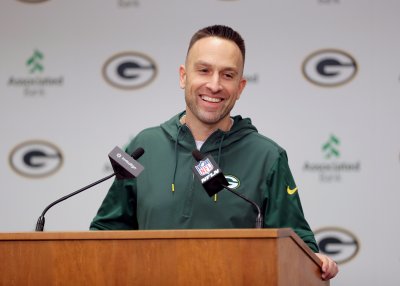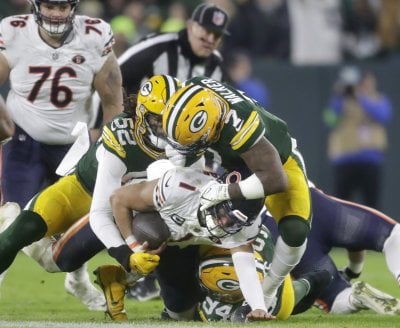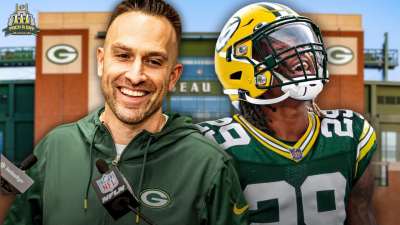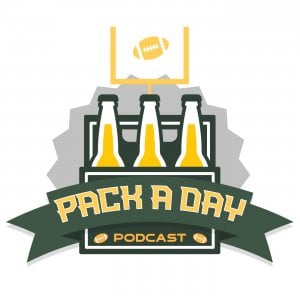Packers Draft Preview, Part 1 (Offense): Mike McCarthy’s Guerrilla Army
By Matt Lynch
In this series, we preview the draft from the eyes of the people who make football decisions for the Packers. In 2016 and 2017, we saw the view from Ted Thompson's suite. This year, we switch perspectives to the coaches—the commanders on the ground.
Football has a military tradition, and football strategies are rooted in military history. We'll discuss the Packers coaches' strategies in that context. Today's Part 1 looks at the Packer offense through Mike McCarthy's eyes, discussing the equipment he needs for his guerilla forces and the 2018 draft prospects who are fit for service. In Part 2 tomorrow, we'll turn to Mike Pettine's defensive strategy: a plan that calls for frying modern quarterbacks' circuitry, then laying siege with a Mongol horde.
The Birth of Mike McCarthy's "Guerilla Warfare" Strategy.
A half-century ago, the Cincinnati Bengals were an expansion team with a roster full of hand-me-downs from other teams. The Bengals didn't have monstrous tanks on the offensive line, capable of bulldozing forward to seize enemy territory. They had Humvee-sized units, too small to drive defensive tackles into retreat. The Bengals' receiving corps wasn't stocked with long-range bombers, threatening to strike deep in the heart of enemy territory. They had slower short-range fighters, durable over the middle but unsuited for catching deep bombs down the sidelines.
Bengals offensive assistant Bill Walsh knew their offense could not win a conventional war against opposing defenses. So, he adopted guerrilla tactics. Instead of threatening overwhelming devastation with long bombs, Walsh's slower receivers could inflict steady damage with precise, short-range assaults. Rather than trying to seize territory with tank-sized linemen, Walsh's small linemen would only seek to bog down the enemy's most powerful units. And he wouldn't have his quarterback launching nukes from a stationary, fortified bunker. Walsh would use mobile command units like Ken Anderson, who could carry out short and intermediate missile strikes from any location in the pocket.
With Walsh's guerilla tactics, the Bengals' forces could hold their own against conventional defenses. When those tactics were carried out by better-equipped armies—as Walsh later had in San Francisco—they were almost unbeatable. Conventional defenses were built to stop conventional offenses, not to win Walsh's guerrilla wars.
* * *
Walsh had several junior officers at different times during his San Francisco campaign. One of them was Paul Hackett, a quarterback developer who was working on artificial intelligence for QBs. Hackett wanted to create a system that would automatically tell QBs where to attack before the ball was even snapped—based on nothing more than the pre-snap positioning of the enemy forces. Once that algorithm was perfected and installed in the quarterback's brains, they would become Robo QBs who always knew where to throw the ball.
Hackett tinkered with Joe Montana's circuitry in the mid-1980s, before the Cowboys hired him away. After three years, new owner Jerry Jones fired Hackett and the rest of the Cowboys staff, and Hackett went into exile at the University of Pittsburgh. There, he mentored aspiring QB programmers like Mike McCarthy, the son of a local tavern owner. Hackett brought McCarthy along to Kansas City in 1993, when the Chiefs hired Hackett to build a guerrilla army like Walsh's 49ers.
In Kansas City, McCarthy learned guerrilla strategy and tactics, and he worked as Hackett's quarterback programmer. In the mid-1990s, McCarthy successfully re-programmed Rich Gannon—a malfunctioning unit already in his 30s—and turned him into a Pro Bowl quarterback. The Saints hired McCarthy in 2000, and McCarthy programmed Aaron Brooks to be a robo QB.
Six years later, Ted Thompson hired McCarthy to lead the NFL's proudest army. He remains in command today.
* * *
QUARTERBACK
"The Missile Command"
OVERVIEW: Conventional offenses use stationary command centers like Ben Roethlisberger, who launch long-range strikes from a heavily fortified pocket. That won't work for guerrilla offenses. They don't have hulking linemen to form an impenetrable barrier around the quarterback, and they need QBs who can move around to create better angles for their short-range throws.
McCarthy finds those kinds of athletes to run his offenses. He brought Aaron Brooks to New Orleans, and in San Francisco chose Alex Smith over Aaron Rodgers—because, in McCarthy's words, the 49ers were worried Rodgers wasn't athletic enough.
ROSTER OUTLOOK: Rodgers is still a robo QB, though one who has taken some damage. Back-up Brett Hundley's software wasn't installed correctly, as we saw in the second half of last year. In the off-season, McCarthy replaced Hundley's programmer with longtime QB coach Frank Cignetti, who helped McCarthy turn Aaron Brooks into a Robo QB in New Orleans. Cignetti will be tasked with fixing Hundley's glitches, and with performing a full-system install on DeShone Kizer—a mobile unit who can fire high-velocity missiles.
DRAFT OUTLOOK: McCarthy has three QBs with functional hardware, and his new programmer has enough work on his plate. He isn't looking for a quarterback this year.
RUNNING BACKS
"The Heavy Cannons" and "The Grenadiers"
OVERVIEW: To run the football, conventional offenses use satellite-guided missiles like the Vikings' Dalvin Cook, or 360-degree Apache helicopters like the Steelers' Le'Veon Bell. But the smaller linemen used by guerrilla offenses can't give those fancy modern pieces the protection they need.
When McCarthy faces fortified enemy positions on third-and-short, he opens fire with heavy cannons like Ahman Green or Deuce McAllister, McCarthy's lead back with the Saints. The cannons can't change direction like the smart-guided missiles and choppers, and they're less likely to penetrate deep into enemy territory. But cannonball running backs an run through brick walls at the line of scrimmage and fall forward on the other side. That's all McCarthy needs. (The real yardage is gained by the receivers in the passing attack, as we'll discuss in the next section.)
Passing downs require more intermediate-range targeting. For that, McCarthy uses a grenadier—a back who can catch the ball and do explosive damage against vulnerable nickel-and dime-package defenses.
ROSTER OUTLOOK: McCarthy has one working cannon in Jamaal Williams, and a crafty grenadier in Aaron Jones. The other units have problems. Ty Montgomery isn't sturdy enough to serve as a heavy cannon. He's likely just a back-up grenadier. The butterfingered Devante Mays can't be trusted in battle; he's liable to misfire and blow up McCarthy's own forces. Aaron Ripkowski was supposed to be able to knock over walls at the line of scrimmage, but he's never functioned as powerfully as advertised.
DRAFT OUTLOOK: A back-up cannon isn't the highest priority purchase for the Packers. But they have extra picks to use in the middle to late rounds this year, and there are a few in that range with some boom:
DIMITRI FLOWERS, Oklahoma. Flowers replaced Ripkowski at fullback for Oklahoma, and the Sooners used him to blow holes in fortified enemy positions. He scored nine touchdowns on 40 touches last year. And if defenses brace the gates to stop him, he can outflank them on screen passes. Flowers had 54 catches in college, including a few rumbles of 50-plus yards.
LATER OPTIONS: Wisconsin's Austin Ramesh can burrow through a bunker, and he'll be available late if he's drafted at all. He fires smaller shells than Flowers as a blocker, but he's better at hitting his mark. LSU's Darrel Williams comes wrapped in the same 5'11", 225-pound package as Devante Mays—the right size for blasting through walls. Unlike Mays, Williams catches passes and doesn't fumble.
* * *
WIDE RECEIVERS
"The Fighter Jets," the "Light Bombers," and the "Medium Bombers"
OVERVIEW: There are several kinds of receivers available for NFL air forces. Some are bombers, either in the light (Trevor Davis) or medium (Jordy Nelson) size. They are mainly used for intermediate and deep strikes along the sidelines and they are essential for conventional offenses that want to carry out long-range bombing campaigns.
Unconventional guerrilla offenses like the Packers need bombers too, as we'll discuss in the tight-end section. But at the receiver position, McCarthy would prefer a fleet of fighter jets, perfect for short-range strikes just beyond the line of scrimmage. The fighters need to be maneuverable enought oe vade traffic in the war zone in the middle of hte field, but sturdy enought o survive heavy hits. Jerry Rice was the best fighter jet in NFL history. Sterling Sharpe was the Packers' best.
ROSTER OUTLOOK: Davante Adams is an all-purpose fighter jet, good for duty in the jungle full of linebackers in the short middle of the field. Randall Cobb is smaller and less heavily armored, likely limiting his use to the slot. Geronimo Allison is the right size and armor but has trouble shaking enemy coverage. Converted basketball player Michael Clark is a medium bomber like Jordy Nelson. He's a threat to haul in deep balls and catches along the sideline, but he doesn't have the maneuverability needed for close combat over the middle. Trevor Davis is a light bomber with dangerous speed, but not enough armor for flying through the thick of the action.
DRAFT OUTLOOK: McCarthy needs another all-purpose fighter jet in his fleet. There are two working units for sale, with different features and price points:
ANTHONY MILLER, Memphis. Miller is only a half-size bigger than Cobb, but he has a fresher engine. Miller has a walk-on's courage over the middle and he's been in the thick of it: he caught almost 200 balls the last two years, for more than 2,800 total yards. He won't go in the first round because he lacks the speed of supersonic models like Odell Beckham, and because, at 200 pounds, Miller's not heavily armored. He'll likely go in the second or third round.
DAESEAN HAMILTON, Penn State. Hamilton will last around or two later than Miller, because he's slower and less dangerous after the catch. But Hamilton is a master dogfighter in his routes, who shook gifted but gullible Big Ten cornerbacks with a variety of tricks and cons. As a freshman, Hamilton bamboozled former Michigan State Spartan Tae Waynes, who is now the Vikings' No. 2 cornerback. To beat the Vikings, McCarthy needs a fighter jet who can out-maneuver Waynes.
* * *
TIGHT ENDS
"The Heavy Bombers"
OVERVIEW: Fighter jet receivers are usually too small or slow to aul in deep passes down the field. That's' fine by McCarthy—guerrilla offenses focus on short-range attacks. But those short attacks won't work if the enemy's deep safeties venture toward the line of scrimmage, cluttering up the backfield. Once there, the safeties can bracket the short-range receivers, and blast them when they catch the ball.
To keep the safeties deep and away from his short-range receivers, McCarthy needs at least one bomber on the field who can threaten defenses with deep-ball strikes. While he's used medium-bomber receivers like Jordy Nelson in the past, McCarthy would rather line up a heavy bomber at tight end. With a heavy bomber at tight end to keep the safeties deep, McCarthy can use multiple smaller fighter jets at receiver for sustained short-range assaults.
ROSTER OUTLOOK: Jimmy Graham was one of the best heavy bombers in the league in his prime, and he's still frightening enough to keep enemy safeties at home. Lance Kendricks, however, is running on fumes.
DRAFT OUTLOOK: Ready-made heavy bombers go early in the draft, and McCarthy has higher-priority needs elsewhere. But this draft has a later-round unit who might be operable, after a year or two of re-conditioning.
ANDREW VOLLERT, Weber State. Vollert comes with a heavy bomber's specs: six-foot-six and fast, perfect for hauling in the deep ball. Unlike many college tight ends, he has a lot of experience in the role. He caught more than 120 passes the last two years, including 12 touchdowns. Vollert's not yet ready for the duty at the pro level, because he's skinny and needs at least a year in the NFL strength and conditioning program. But he's a team captain who's likely to put in the work. If all goes well, by 2019 or 2020, Vollert could be ready to take over for Graham as McCarthy's heavy bomber from the tight-end spot.
* * *
OFFENSIVE LINEMEN
"The Humvees"
OVERVIEW: The Packers don't occupy territory with Panzer divisions of 330-pound linemen, like many conventional offenses do. Large linemen are less mobile, and guerrilla armies need to be nimble. McCarthy uses smaller Humvees. They aren't big enough to push defensive linemen off the ball, but they'll fight like hell to keep dangerous defenders tied down and his mobile quarterback safe. T.J. Lang is a prototypical Humvee. He could play any position on the line, and he never gave enemy forces an easy advance.
ROSTER OUTLOOK: McCarthy has three working Humvees in David Bakhtiari, Lane Taylor, and Corey Linsley. He might have a fourth in Bryan Bulaga, but he's suffered a lot of wear and tear. The remaining units are missing one of three necessary ingredients for a good Humvee: mobility, reliability, or ruggedness in combat.
DRAFT OUTLOOK: This draft has a few promising Humvees, at different price points.
THE EARLY-ROUND OPTION: AUSTIN CORBETT, Nevada. Corbett has "Mr. Reliable" stamped on his forehead. He has a walk-on and team captain. He's married to his college sweetheart. He wants to be a doctor when his NFL tour of duty is over. And he comes with the perfect dimensions for this unit: 6'4", 310 and athletic. Corbett will probably go in the second round, the "premium showroom" spot for Humvee linemen.
THE MIDDLE-ROUND OPTION: COLE MADISON, Washington State. Madison just finished a four-year tour as a Humvee in a junior guerrilla army. Mike Leach's Cougars throw the ball 55 times a game, and Madison reliably protected their quarterback for four years. He's on the budget lot because he doesn't have Corbett's power or maneuverability. But he does have starting experience at right tackle, where Bulaga's injuries remain a cause for concern.
THE LATE-ROUND OPTION: AARON STINNIE, James Madison. Stinnie was also a college Humvee in a guerrilla attack, Mike Houston's spread offense. He twice earned FCS All-American honors in that role, and—as a former high school basketball player—he comes equipped with excellent handling. He'll be available late because he's not ready for immediate use. Stinnie hasn't faced the kind of firepower he'll encounter in the NFL, and he hasn't been trained in pro-level tactics. He's another team captain who is likely willing to put in the work.
* * *
LONG-SNAPPERS
"The Evacuation Force"
OVERVIEW: Sooner or later, every NFL army finds itself surrounded. If McCarthy's guerrilla's made progress, he needs a reliable kicker to lock in gains. If their campaign failed, he needs a punter to send the enemy forces back deep 'in their own territory. And for both jobs, eh needs a reliable evacuation team to ensure that the retreat goes smoothly. That's the long-snapper's job—and if he doesn't do it, the enemy can rout McCarthy's retreating army and inflict six-point damage.
ROSTER OUTLOOK: Brett Goode is a veteran evacuator, but he's broken down and retired. The Packers brought in Zach Triner, a new kid fresh out of school.
DRAFT OUTLOOK: Highly trained long snappers don't come out of college very often, and any coach would rather put his trust in a veteran. But there is a special one available in the draft this year, who has more than the standard basic training:
TANNER CAREW, Oregon. If McCarthy must use a rookie long-snapper, then he'd rather it be someone like Carew, whose parents sent him to work with former pro snappers as a youth. Carew also played through an ACL tear in a BCS playoff game against Ohio State—proving he'll sacrifice his body to ensure a guerilla army's safe retreat from the enemy.
That's it for today. Please check back to Part 2 tomorrow, when we look at the draft prospects who seem suitable for service in defensive coordinator Mike Pettine's modern Mongol horde.












Comments (22)
gr7070
April 24, 2018 at 04:22 pm
Lynch writes the greatest Packer draft articles available and definitely the best content Cheesehead TV publishes.
Turophile
April 25, 2018 at 08:41 am
Way to go, sustaining a metaphor over such a large piece. Very nicely done, a good take and a great read.
Spock
April 25, 2018 at 10:26 am
Q: "What's a metaphor?"
A: "Grazing cattle."
worztik
April 24, 2018 at 04:55 pm
Interesting!!!
Bert
April 24, 2018 at 04:57 pm
Too bad John Facenda isn't around. He was great with the football/military metaphors.
stockholder
April 24, 2018 at 05:50 pm
This sounds more like the Planet of the Apes, then Gorilla warfare. So lets sort this into: Gorillas - military officers; Chimps - Science officers ; orangutans - are politicians; TT was our military leader: has claimed any ape could be a leader. That football is more like the Civil War than modern warfare. That the chimps- are The coaches. And the politicians are the owners, and commissioner. The politicians/packers Board; changed the thinking when Gute took over. And the chimps swung from one tree to another. MMs birth is ok for Our Cheeta or Alpha chimp. Family Roster out look. Rodgers is his mate. He can throw THE Hail Mary. He wins games that can't show enough offense otherwise. MM moves a Wr to Rb. He Flips an offensive wall; that can't push anybody for yards. He played TTs draft picks to keep his job. Draft Outlook: The more picks we have the better! Wrs will be the calvary this year. They'll save the runners from getting creamed. And assure everyone there is hope. Roster Outlook. All purpose doesn't work for me. The proper thing is to give A-Rod a protective line so he doesn't get hurt. IMO we need horses! We need ammunition. We need reinforcements!
Bert
April 24, 2018 at 06:15 pm
Thanks. I feel so much better after reading your post. Totally confused but better......
PatrickGB
April 24, 2018 at 06:17 pm
I retired with 22 years of active duty and attended the Army War College. It was fun to read this. Some of the comparisons were off a bit. Some analogies don't really fit with modern warfare machines. And the methods described are not really guerrilla warfare. But to complain would be petty. The overall article was fun to read and filled with good information and analysis.
I really enjoyed another take on MM's offense and his history with it.
Good job.
Duneslick
April 24, 2018 at 06:33 pm
Worst draft article I have read. Someone had to say it. Silly
Matt Lynch
April 24, 2018 at 06:56 pm
Duneslick, I understand if the military analogies didn't work for you. I may have overdone it a bit. I'm trying to find ways to help readers visualize the bigger picture that goes into schemes and the players needed for them - something that's easier to visualize than playbook-speak. But take a look after the draft at how many of the Packers picks are the guys identified in this article (and Part 2 tomorrow) - I think the analysis is sound. I'll think about other ways to explain it next year.
flackcatcher
April 25, 2018 at 07:41 am
Like Patrick GB I enjoyed your article very much. Yeah you did push the military analogies a bit to far, but football is the one sport where the fan can see stratagems enacted in real time. That very simple fact makes football really fun. (Gorilla football. heh heh heh.....0:)
Duneslick
April 25, 2018 at 12:58 pm
My response was a little harsh. I understood the football terms/ideas and found it hard to sift through the military analogies to get to the football facts. I think a lot of the football logic and research is correct. I do have respect for someone who writes and spends the time to produces such a long article. The scheme just did not work for me and that's more about me.
Donster
April 25, 2018 at 06:58 am
Really enjoyed reading your article Matt Lynch. A nice change of pace look at the team and what its needs are. Looking forward to Part 2! Well done!
Oppy
April 25, 2018 at 08:41 am
Fun article, but I question the outlook of how MM's offense in regards to the WR position is conceptualized.
Actually, I question how Rodgers implements the offense.
MM continually refers to his offense as "vertical". He clearly believes that a necessary element is stretching the field. That's not to say that MM's offense doesn't call for hitting receivers underneath; I believe it does.
That being said, how often do we see Rodgers getting the ball out quickly and hitting "fighter jets" just past the line of scrimmage as you suggest? Rodgers regularly looks right past open WR's within 5-7 yards of the LOS, holds the ball until he has to scramble out of the pocket, all the while looking for the deep toss.
MM's offense may need guys to work the underneath routes to work on paper; but in practice, stocking up on "fighter jets" to play "just past the LOS" is going to be wasted picks unless Aaron Rodgers starts paying attention to those routes and putting the ball on those WR's on time.
bbrochel
April 25, 2018 at 03:05 pm
MM is from the west coast coaching tree but his offense is very different from the Bill Walsh/Mike Holmgren offense. As you state you don't see the timing and rythme throws in this offense (really miss a good old slant route). I see a mixture of Air Coryell's vertical passing which plays to Aaron Rodgers strengths with extending plays and his deep ball accuracy.
Oppy
April 26, 2018 at 10:40 am
MM is definitely a product of Schottenheimer and Hackett influence.
That said, the typical WCO route trees are present in MM's version. There's throws to be made underneath. Rodgers has a monster arm to be sure, but he has pin point accuracy and the ability to throw lasers. Those timing and rhythm throws should be his bread and butter. Unfortunately, in my (unpopular) opinion, Rodgers' lack of trust in most WRs and his just-a-bit over the top fear of making a mistake (pick) keep him from delivering a ball, especially over the middle, in all but the safest, most sanitary circumstances. Those quick hitting timing routes often require getting the ball out of your hand before the WR makes his break and sometimes you're throwing into some traffic. Rodgers seemingly does not trust that his WRs will make the play and fears he'll throw a pick. Seems to get a little worse every year. It limits our offense. The throws are there for the taking.
porupack
April 25, 2018 at 09:13 am
Matt,
Enjoyed your article, lots of creativity to provide some cohesion to MM possible strategies. Afterall, that's why we read analysts like you, since no coach is going to telecast his strategies to the public.
Of course, no analogy is without flaws, but you really sustained it well throughout the article.
However, this part I found most problematic, and I would expect the other way around: Jordy Nelson served to take the Defense deep (heavy bomber role?) and allowing TE to outmaneuver Dfense LBs in middle and medium areas of field. Same effect as RBs rolling out for short dump passes. Here is the section that gave most question for me, and in terms of draft, I think MM would try to find a 2nd rounder (Jordy, Jennings, Devante). Let's call that a forward, stealth "ranger", able to sneak deep in enemy territory and create communication confusion. can you add more insight as pertains to draft? (ie settle whether pack will focus on a top round investment for TE or WR?
to keep the safeties deep and away from his short-range receivers, McCarthy needs at least one bomber on the field who can threaten defenses with deep-ball strikes. While he's used medium-bomber receivers like Jordy Nelson in the past, McCarthy would rather line up a heavy bomber at tight end. With a heavy bomber at tight end to keep the safeties deep, McCarthy can use multiple smaller fighter jets at receiver for sustained short-range assaults.
PatrickGB
April 25, 2018 at 09:33 am
This was his playbook from NO. http://www.footballxos.com/download/2004-new-orleans-saints-offense-pdf/...
I dont know if one can link to it but it backs up this article.
Oppy
April 26, 2018 at 10:41 am
Pretty cool web site! I assume you coach high school ball or something?
LambeauPlain
April 25, 2018 at 10:26 am
Interesting article, General Lynch.
I do hope the Pack takes Miller. Of all the video I watched on prospects, Miller's was the best highlight reel. Fitzpatrick's and Smith's close behind.
Miller is a warrior. He can strike at all 3 levels with impeccable route running, great at yards after the catch, and his ability to separate from DBs with his cat quick fakes while running a route makes them look foolish at times.
I hope Mays is given a good shot this year. He was a great back in college and didn't fumble. I am thinking he was snake bit by unusually bad luck. He's a Abrams MI tank...powerful, big and fast.
I would also like to see Austin Ramesh in Green Bay. He's another tank who can catch passes with ease.
Tundraboy
April 25, 2018 at 01:55 pm
Let's just hope MM becomes more like Grant and Sherman than McClellan.
mikesherman
April 25, 2018 at 07:32 pm
Like the outside the box thinking for this article, very creative. Great read and much more appreciated than just throwing up another mock draft. Keep up the good work!